
|
|
|
|
|
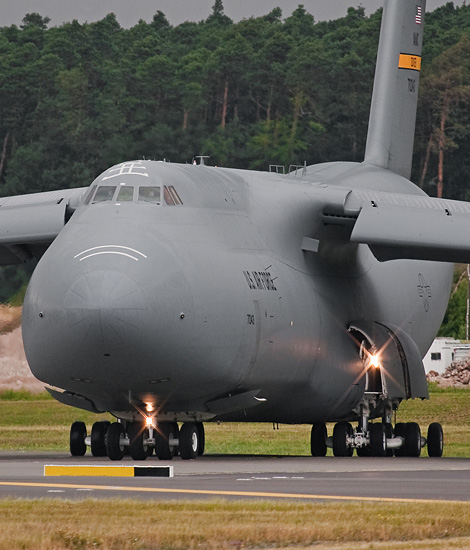
|
The USAF Air Mobility Command; Ramstein Air Base, June 22, 2007
Die Deutschland-Tour 2007: Teil 5; Text and Photograph's by Alex van Noye
My final visit during my five-day trip through the southern part of Germany was again at Ramstein AB on Friday,
June 22. Also today it would be a day filled with transport planes and tankers of the United States Air Force.
Almost all transport aircraft of the USAF are assigned to the Air Mobility Command (AMC).
The Air Mobility Command (AMC) was established on June 1, 1992. It was formed from elements of the Military Airlift
Command (MAC) and the inactivated Strategic Air Command (SAC). It is a combination of the global air transport system
of the MAC and the tanker fleet from SAC. This merge was the result of the collapse of the Soviet Union. The threat
from the East was gone and there were cuts in funds because of that. The mission of the Air Mobility Command is to
provide global mobility to U.S. troops and its partners. The command also plays a crucial role in providing humanitarian
assistance at home and in the rest of the world. The AMC provides together with the Air National Guard (ANG) and Air
Force Reserve Corps (AFRC) global air mobility. The refueling of the Air Force units is a major task of the AMC. Another
special function of the AMC is the evacuation of wounded soldiers and aero medical missions. U.S. forces must be able
to intervene quickly in hostile areas where a strong enemy is active. They need this fast and accurate performance to
take control over the area to end a conflict. Rapid global mobility is central to the U.S. strategy in these situations.
The AMC is able to rapidly deploy U.S. troops anywhere in the world. Besides this, the AMC is also able to continue to
support this force by reserves such as; food, medicines and materials. The AMC is therefore a very important branch
within the USAF.
Besides all mobility functions, the Air Mobility Command has the task to set up temporary airfields in various crisis
areas. These operations require an enormous coordination, speed is therefore very important to supply the front lines
in time. Finally, the AMC is also responsible for the presidential transport with Air Force One. The main aircraft used
in the AMC are the very large transport aircraft and several tankers. The main transport aircraft are; the C-5 Galaxy,
the C-17 Globemaster III and the C-130 Hercules. The C-17 Globemaster III has replaced the outdated C-141 Starlifter the
|
|
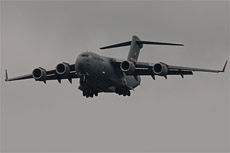
|
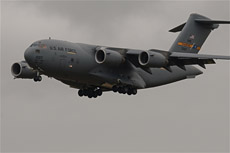
|
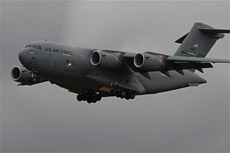
|
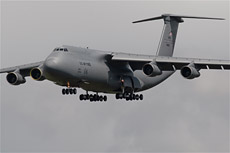
|
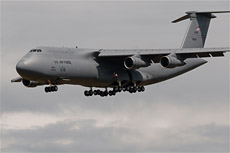
|
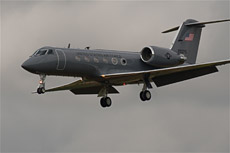
|
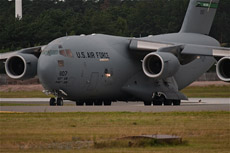
|
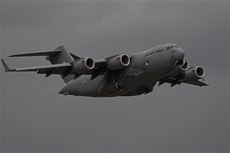
|
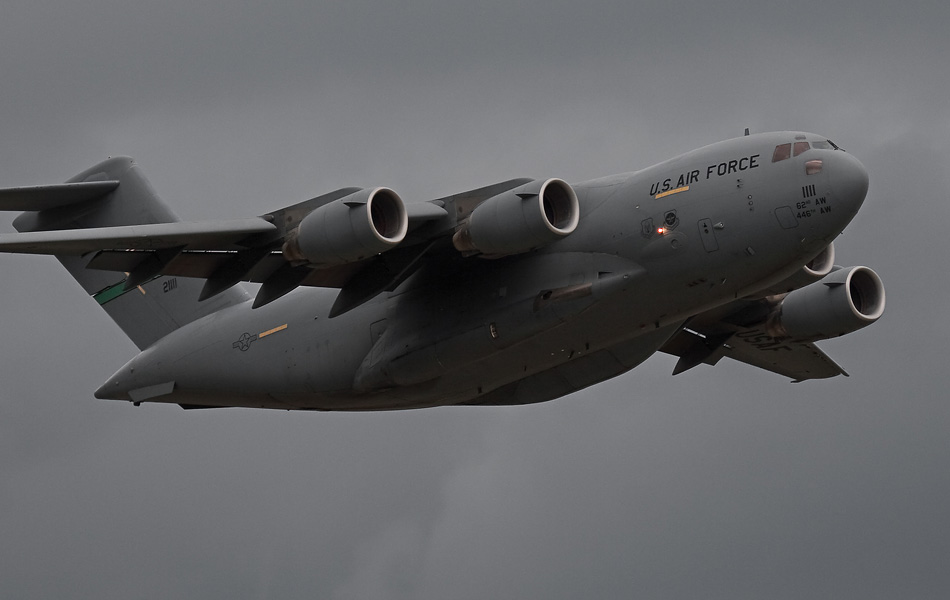
|
last few years. The major long distance tankers in the AMC are the KC-10 Extender and the KC-135 Stratotanker. Besides
this fleet of heavy transport aircraft, the AMC is also equipped with a few civilian aircraft from the Civil Reserve Air
Fleet. They are used to support the AMC fleet during a crisis. The Civil Reserve Air Fleet consists of chartered cargo
aircraft of various commercial companies. These aircraft will be deployed in times of crisis on less hazardous routes;
the USAF transport planes can fly on other more dangerous routes.
Today I visited Ramstein Air Base again. The weather today was less good than the day before. Especially in the morning
the field was covered under a thick layer of gray clouds. The afternoon consisted of heavy rainfall and periods of sunshine.
Especially at moments of sunshine it was great shooting. The traffic today consisted for ninety percent of C-5 Galaxy’s and
C-17 Globemaster III's. In the morning hours it were mainly the C-17's that came in and in the afternoon it were mainly the
Galaxy's which left Ramstein. The first aircraft which came in during this visit to Ramstein were two C-17’s. The units
in which the aircraft flew were units from the very first hours of the C-17 age. The first C-17 that came in was of the
437th Airlift Wing which is based at Charleston AFB in America. The second C-17 was of the 62nd Airlift Wing which is based
at McChord AFB. The first C-5 appeared on the horizon thirty minutes after the landing of those C-17’s. This aircraft was
assigned to the Air Force Reserve Corps (AFRC). This large plane hung almost motionless in the air and it was visible that
the plane was very heavily loaded with cargo. Also the local traffic started to fly. A C-20 of the 86th AW from Ramstein
took off. This aircraft started to fly circuits at Ramstein. This aircraft was flying around in a white color previously,
but nowadays they are painted gray like the other AMC aircraft. Another C-17 appeared at the head of the runway. The
aircraft was waiting until the runway was clear because the C-20 came in for landing. This C-17 was from McChord. These
aircraft are identified by the green tail band. The aircraft left finally after twenty minutes of waiting.
The weather was about to change. The dark gray weather gave way to sunny periods interspersed with heavy showers. A C-17
appeared at the head of the runway. The C-17 was pretty heavily loaded, because this aircraft remained very low at the end
of the runway. Taking a few decent shots was not a problem. The aircraft was beautifully illuminated while the background was
almost black. The highlight of the day appeared after the departure of the C-17. A Galaxy from Dover AFB was about to leave
inbound America. This enormous aircraft taxied to the runway over the taxi track across the runway. The C-5 is distinguished
by its high whistle while taxiing. The big plane had to wait a while on the other side of the runway. The 28 wheels counting
machine moved to the runway after a while. I was able to photograph the aircraft from all possible angles. When I made a
number of detail shots, I saw how big that plane is.
The weather became really bad after the departure of the C-5. It started to rain very hard. Another C-17 left Ramstein
during this heavy shower. The photo looked almost a night shot because of the gloomy weather. Another C-17 appeared at
the head of the runway after the departure of the C-17. The C-17’s were both from the 60th Air Mobility Wing, based at
Travis AFB. The rainfall was heavy, but the photos were beautiful. The lighting of the C-17 was stunning. After the
departure of the C-17, the weather became better. The heavy clouds gave way to a hazy sun. It was already 7 pm. The
last device that I would shoot during my tour in Germany was a C-5 Galaxy. My tour through the southern part of Germany
was over after the departure of the C-5. I lest home after a very good week in the southern part of Germany. I had made
more than 2000 photos during this journey.
|
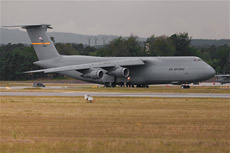
|
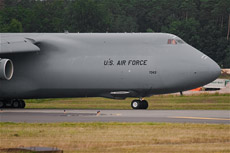
|
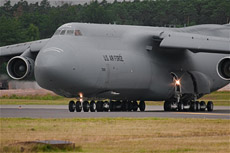
|
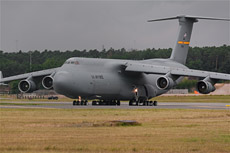
|
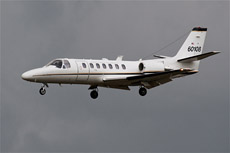
|
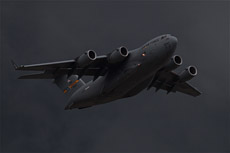
|
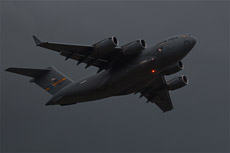
|
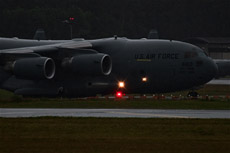
|
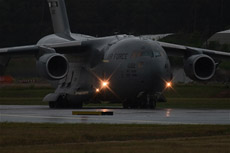
|
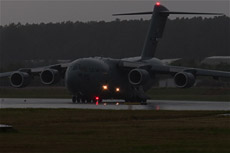
|
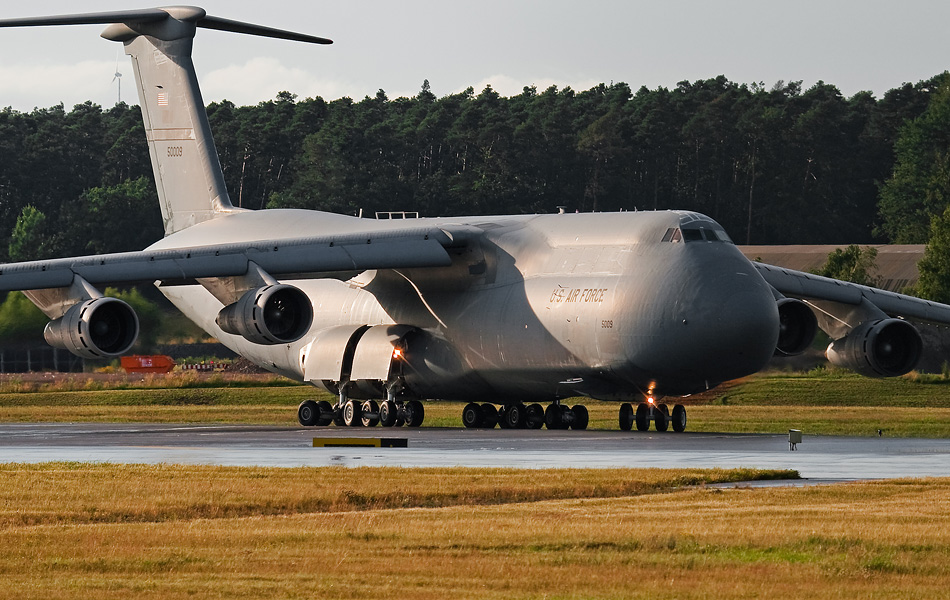
|
|
|

|







